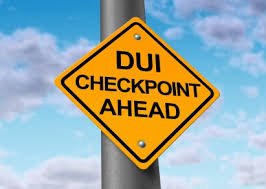OK TO PLACE A SIGN IN WINDOW AT A CALIFORNIA DUI CHECKPOINT REFUSING TO COMPLY?
 There are plenty of videos online showing motorists stopped at a checkpoint. Typically the checkpoints are either immigration checkpoints or DUI sobriety checkpoints. The videos are filmed in various states across the United States and are usually intended to show a citizen how to exercise his constitution rights for freedom from unreasonable searches and seizures under the 4th Amendment. What is important to understand, however, is that different jurisdictions are governed by different laws which dictate that jurisdiction’s standard as to what is an unreasonable search or unreasonable seizure.
There are plenty of videos online showing motorists stopped at a checkpoint. Typically the checkpoints are either immigration checkpoints or DUI sobriety checkpoints. The videos are filmed in various states across the United States and are usually intended to show a citizen how to exercise his constitution rights for freedom from unreasonable searches and seizures under the 4th Amendment. What is important to understand, however, is that different jurisdictions are governed by different laws which dictate that jurisdiction’s standard as to what is an unreasonable search or unreasonable seizure.
Immigration or border patrol searches are typically governed by Federal law. Sobriety checkpoints are governed by both Federal law and the state law for the state that the sobriety checkpoint occurs.
For purposes of today’s blog entry the focus is on California law regarding DUI / Drunk Driving sobriety checkpoints.
The current trend in sobriety checkpoint videos is to show a driver driving through a checkpoint with a sign on his window indicating that he will not be complying with the checkpoint. When the observer watches the video, I would advise looking to see where the video sobriety checkpoint occurred. It is very doubtful that a driver can successfully avoid compliance with a sobriety checkpoint in California by posting a sign on his window indicating that he will not comply with the checkpoint. California law makes it mandatory that a driver of a motor vehicle stop and submit to a sobriety checkpoint inspection conducted by a law enforcement agency when signs, and displays are posted requiring the stop as well as certain requirements in administering the checkpoint.
What is noteworthy is that the law enforcement agency has signs and displays requiring that stop. If both are absent it can be argued that the driver need not stop. What is also interesting is that the driver submits to the sobriety checkpoint inspection. This means that the driver must comply with implied consent – meaning each driver must provide a blood, breath, or in some cases urine sample when requested by a law enforcement agency at a sobriety checkpoint. There is no mention of 4th Amendment rights or probable cause protections to the driver.
What is not stated, however, is that other than providing proof of insurance, registration and driver’s license, the driver doesn’t need to answer the officer’s questions that may be incriminatory or that the driver must perform field sobriety tests.
The California driver apparently still retains protection against compelled speech under the 5th Amendment and field sobriety tests remain optional.
Lastly, a driver can avoid entering a sobriety checkpoint if he can legally exit the street prior to entering the checkpoint area. If a driver commits a vehicle code violation while trying to avoid a checkpoint, then the driver will likely be stopped for the vehicle code violation.
Well, I hope you found this recent edition of the DUI blog helpful to understanding complicated nature of DUI defense and sobriety checkpoints.

Myles L. Berman, Top Gun DUI Defense attorney offers unwavering support and strategic defense in DUI cases across Southern California. Experience a personal commitment to protecting your rights and securing positive outcomes.
Call now for a FREE case evaluation (888) 486-7486


